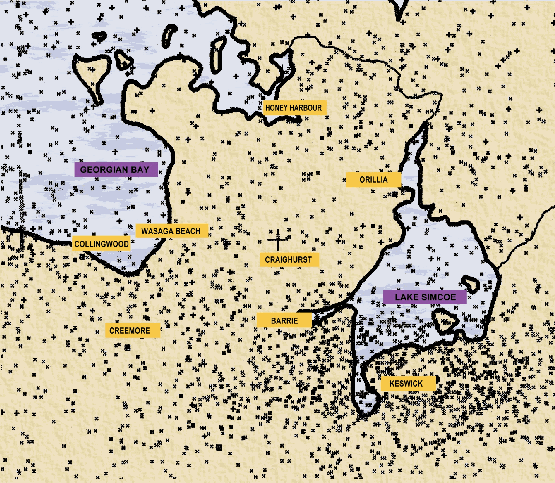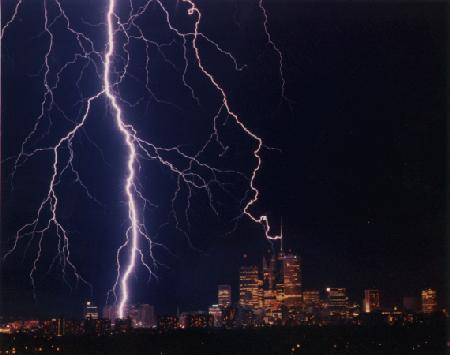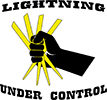Frequently Asked Questions
Lightning protection systems consist of :
Strike Termination Devices (Lightning Rods)
The lightning rods are positioned at strategic locations where lightning is most likely to strike, such as roof peaks/ridges/edges, dormers, chimneys/stacks, cupolas, spires, and roof mounted mechanical equipment etc. They will become the targets for a lightning strike, protecting the structure in their proximity.
Primary Lightning Conductors
High surface area, braided bare Primary Lightning Conductors interconnect the Strike Termination Devices (Lightning Rods) to the Grounding System providing a low impedance path for the lightning to reach the grounding system.
Bonding conductors
Bonding conductors provide potential (voltage) equalization between the lightning protection system and other grounded metal bodies on a building such that the lightning energy travels on the primary conductors. Bonding prevents large voltage differentials that cause arcing and induction.
Grounding and Energy Dissipation
The grounding system provides a means for the lightning energy to dissipate safely into the ground and away from the structure. Ground rods, Ground Plates and primary sized Grounding Cables are used to provide this.
The lightning protection system works by continuously discharging static electricity in the air during electrical activity in the atmosphere. When a storm is severe enough to create a direct strike, a properly installed lightning protection system will intercept the strike and conduct it safely to ground.
The system acts as an external shield to provide the path of least resistance to ground for any lightning or atmospheric electrical activity.
To PREVENT the damage that a lightning strike can cause:
- Electronic products are among the most common items we purchase in our homes. Aside from the obvious items such as audio/visual equipment, computers, security systems, etc., devices that we don’t think of as being electronic are adopting electronic elements, such as heating/air conditioning systems, refrigerators, timers, telephones, garage door openers, and a host of new products we will be using in the future. These products are vulnerable to even mild power surges, let alone the effects of a direct strike. Even when power is switched off, lightning can arc through the switches and breakers. Without a lightning protection system, the building’s electrical system provides the best path for lightning to reach ground.
- Electrical wires in buildings are designed to carry voltages and current (115 volts and usually 15 amps) to supply the connected electrical and electronic appliances. The wiring is not designed to carry the voltages and current of lightning (millions of volts and thousands of amps). The wires or insulation can melt and re-solidify in a non-uniform manner, or the insulation could have been perforated by the effects of lightning arcing. This type of damage is extremely difficult to detect, is cumulative and the consequence may be that there is an increased chance of an electrical fire starting in the future and lightning may never be suspected as the cause.
- Fires are caused by lightning. Even a localized fire in the attic that is caught early can cause tens of thousands of dollars of damage due to the water the fire fighters use to extinguish the fire. Even if the fire is minor, the musty, smoky smell that lingers for years in carpets, furniture, and drapes can ruin them. When lightning strikes a fireplace chimney or vent, lightning energy can start a fire in the living space of a home. Lightning can cause delayed action fires that can go undetected for a long time after the actual lightning strike.
- Breaches and explosions can be caused by powerful lightning strikes. The property damage caused by this type of strike takes the form of holes in roofs, pulverized chimneys, and structural damage. Lightning that is powerful enough to cause explosions can also claim life.
Your cottage is susceptible to the same kind of lightning damage that your home or building is. Add to this some additional considerations:
- Many cottages are in rocky terrain with poor natural grounding. This means that if you have electricity, telephone, etc. in your cottage, the wiring system will be by far the best path to ground for lightning. It will be even more likely that appliance and wiring damage occur.
- Tall trees can attract lightning and the shallow roots of trees in rocky terrain can channel the lightning to the cottage electrical system. As trees are poor natural conductors, side flashes from the trees can cross to the cottage easily.
- Cottages are unoccupied for long periods of time. Lightning-caused damage can go undetected for quite a while. In particular, a small lightning-caused fire that could easily be put out in an urban setting may cause the whole cottage to burn down because nobody was there to stop it.
- Usually, cottages have even more wood construction than houses. This makes fire damage even more likely.
No, the exact opposite! A TV antenna or other mast that protrudes significantly above the home increases the chances of attracting a lightning strike, much like a church steeple. These towers are rarely grounded to the standards of the Lightning Protection Codes. Also, the antenna/satellite cable, provides a direct path for lightning to enter a home directly into the sensitive electronic products (VCR/receiver/TV). Part of any professionally installed lightning protection system includes the proper grounding of the antenna mast.
The following map represents any typical storm occurrence throughout south/central/east Ontario.
Although this map shows peak lightning activity in the Barrie/Lake Simcoe area, peak activity can occur anywhere in any storm zone.
Every season there are between 30 and 35 days with thunderstorm and lightning activity. There can be up to 40 strikes per square mile in any given area in a season.
If Lightning Storms occurred 35 days in a row, the danger that lightning presents would be brought into sharp focus.
Although you and your family may not always be aware of, or exposed to, the effects of the storm, your home is.
Because this activity recurs every season, the cumulative effect suggests that it is not a matter of “if” but a matter of “when”.
Lightning Strikes? More than we think!!

Map Shows Storm Activity
Date: August 31, 1995
Total strikes: 2776
Length of storm: 12.5 hours
Strikes per sq. mile: Average 1.15, Maximum 3.89
The exact location of any one lightning strike cannot be predicted; however, the structures that are most prone to lightning strikes are those in :
- isolated flat areas where the building is the highest point
- buildings covering a large area
- buildings on higher ground
- in the proximity of large, tall structures such as towers or trees
Specific targets for lightning strikes to a building are protruding structures on roofs such as chimneys/stacks, antenna/towers, mechanical units, etc.
Do not be lulled into a false sense of security just because your building is not the highest point around. We can cite several examples where buildings on flat surfaces have been struck, while buildings on nearby higher land were not. Our experience shows there are no guarantees.
No. All you have to do is watch the CN Tower during a thunderstorm. Observers have seen the tower hit 20 times during one storm alone.
Yes and No:
Yes. Insurance for your home or building will generally cover major lightning damage, such as explosions, breaches, and fires caused by a direct strike, depending on your policy. If you are in any doubt, check with your insurance company.
No. It does not cover all damage. Most policies have a deductible and if the damage is less than your deductible, you must pay for it. A lot of insurance policies have a deductible of $1000 or more. If a lightning strike damages electronics, chances are a replacement unit will be less than your deductible, and you will have to cover it yourself. Also, some damage, such as damage to wiring, is difficult to attribute directly to a lightning strike and must be proven before it will be covered. It’s up to the owner to prove that damage or degradation occurred to the wiring. If your home has been struck in the past and the insurance company has already covered significant claims, your premiums may go up or the insurer will refuse to cover the building.
A lightning protection system is a truly proactive measure, it PREVENTS the problem from happening rather than dealing with the damage after it has occurred. Damage like:
- Irreplaceable family heirlooms may be lost forever.
- The months of hassle and expense of repairs or replacement of property. Although insurance may cover the major cost of a claim due to lightning, your lifestyle is disrupted and, if your time is important to you, it is wise to avoid the problem.
- The degradation to electrical wiring that may go undetected/unproven.
- Some insurance companies offer premium discounts on farm buildings equipped with lightning protection.
Yes.
There are authorities having jurisdiction in both Canada (Canadian Standards Association – CSA) and the U.S. (National Fire Protection Association – NFPA). These authorities publish the codes and standards that define today’s lightning protection system. Refer to the “Codes and Standards” in the Services page.

Today’s lightning protection systems, installed by professionals, are remarkably unobtrusive and blend into the architecture. Rods extend approx. 1 foot above the roof peak or building edge and are 1/2” diameter. Cable is either braided copper or aluminum (1/2” diameter) and is installed considering the roof sight lines and architecture. Where cables come down to ground, they are hidden as much as possible by corners, eaves troughing, and downspouts.
Dominion Lightning Rod Co. guarantees the materials and workmanship for one year. The materials are designed to last longer than the building itself, so any problems should present themselves before the end of the warranty period.
If the components of the LPS are not disturbed, very little if any. A certified lightning protection system should last as long as the building itself. The system is designed to withstand numerous lightning strikes without degradation. It should also withstand most weather conditions the roof itself could withstand. We recommend that the system be visually inspected every 3 years, to assure rods and cables are fastened tightly to the roof and walls.
If you have had any repairs or modifications done to the exterior that may have affected the system such as re-roofing, the lightning protection system should be re-inspected and re-certified by a qualified LPS installer.
To receive an estimate for any of our services, please fill out the request for information in the Contact Us Page with a description of your needs. We will get back to you by phone or e-mail to qualify your request.
For construction tenders, we receive requests by contractors and we require electrical and architectural drawings, applicable specifications, addenda, and closing dates.
For new construction projects where we are requested to design-build a system and provide a quotation, we require architectural and electrical drawings site locations, basic construction schedule.
For existing buildings, where retrofit of Lightning Protection is requested, we require a site location, elevation photos of the existing building showing the ground to the roof top around the entire building.
Yes.
Please fill out the request for information in the Contact Us Page with a description of your needs. If you know what products you wish to purchase, list them by part number and quantity and we will provide a unit price estimate by e-mail.
If you are unsure of how to install a system on your building or what materials you need, we would be please to provide an estimate to design-build a system for you. For details see the previous question.
When selling materials directly, we require a waiver to be completed that indemnifies Dominion Lightning Rod from the improper installation of the materials by the purchaser. Due to the uniqueness of each system, we are unable to offer advice about installations on systems we do not install.
To protect your electrical/communication systems from damage, we recommend our industrial quality surge protection unit that can handle the voltages and current produced by lightning (20,000 amps, millions of volts). Power bars and surge protection units available through retail stores are not designed to protect your equipment from the power of lightning.
Dominion Lightning Rod Co. has been providing lightning protection systems as its sole business since 1898. We have an excellent reputation among professionals in the industry. We are members of the advisory committee for the CSA code for Lightning Protection and have designed, supplied, and installed lightning protection systems on many different structures. Please refer to the Projects page.
As a family business currently in the 6th generation of ownership, we are 100% Canadian owned and operated, and fully committed to our customers.


